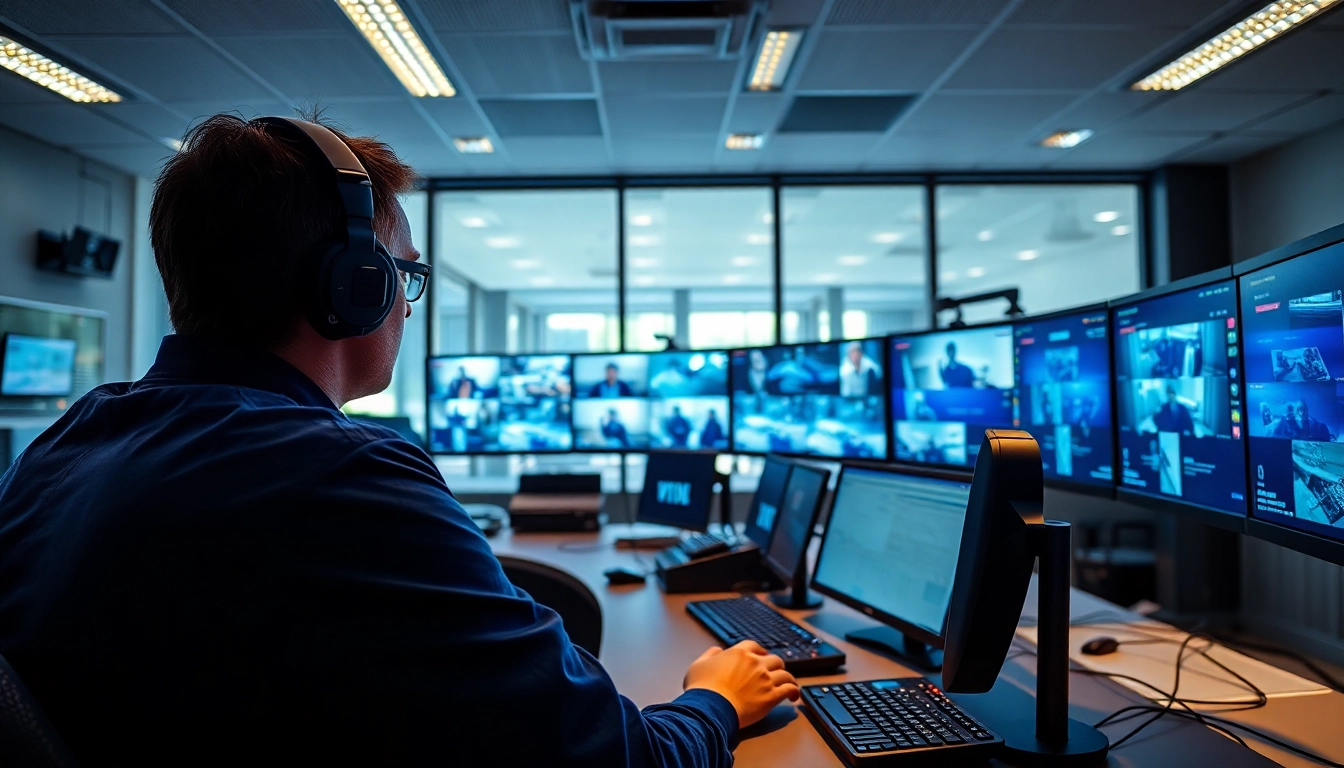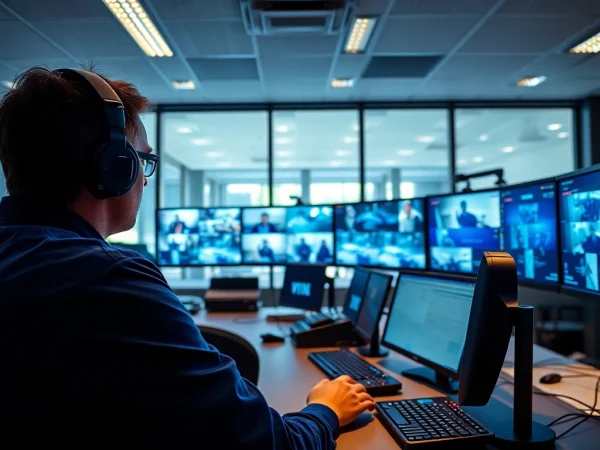Comprehensive Guide to Efficient CCTV & Remote Monitoring Solutions
Understanding CCTV & Remote Monitoring Systems
What is CCTV & Remote Monitoring?
CCTV, or Closed-Circuit Television, is a system of video cameras that transmit a signal to a specific set of monitors, primarily for security and surveillance purposes. In combination with remote monitoring, this system allows users to view live footage or recorded video from any location where internet access is available. The integration of these two systems enables stakeholders to maintain control over their premises without the need for physical presence, which is particularly beneficial for businesses and residential areas alike. As technology evolves, so too does the sophistication of CCTV & Remote Monitoring, leveraging enhanced camera capabilities, automated alerts, and artificial intelligence to enhance security measures. For more on advanced security solutions, explore CCTV & Remote Monitoring.
Key Components of CCTV Systems
A robust CCTV system typically consists of the following components:
- Cameras: These capture video footage and come in various formats such as dome, bullet, or PTZ (pan-tilt-zoom).
- Recording Device: Digital Video Recorders (DVR) or Network Video Recorders (NVR) store video footage for future reference and analysis.
- Monitors: These display the live feed or recorded footage, allowing operators to oversee multiple camera feeds simultaneously.
- Cabling and Connectors: Proper installation of coaxial or Ethernet cables ensures a stable connection between components.
- Remote Access Software: This enables users to access live and recorded footage from their devices, including smartphones and tablets.
Benefits of Remote Monitoring in Security
Remote monitoring offers several distinctive advantages that enhance the efficacy of traditional CCTV systems:
- 24/7 Surveillance: Remote monitoring allows for continuous observation, ensuring that any suspicious activity is detected and addressed immediately.
- Real-Time Alerts: Automated notifications can be sent to security personnel should unusual behavior be detected, facilitating prompt responses.
- Cost Efficiency: By reducing the need for on-site security staff, organizations can save on personnel costs while still ensuring safety.
- Accessibility: Users can monitor their premises from anywhere, providing peace of mind and flexibility.
- Data Analysis: Enhanced software may utilize AI algorithms to analyze patterns in the footage, predicting potential security threats.
How to Choose the Right CCTV & Remote Monitoring Solution
Factors to Consider When Selecting CCTV Systems
When choosing a CCTV system, consider the following factors:
- Purpose: Determine whether the primary goal is deterrence, evidence collection, or both.
- Location: Indoor or outdoor installation needs may dictate camera type (weatherproof, night vision, etc.).
- Resolution: Higher resolution cameras provide clearer images, making identification easier in case of incidents.
- Storage Capacity: Assess how long footage needs to be stored and what storage method (local or cloud) is preferred.
- Scalability: Choose a system that can grow with your needs, allowing for additional cameras or features as necessary.
Evaluating Remote Monitoring Services
When assessing remote monitoring services, keep the following criteria in mind:
- Reputation: Look for reviews or testimonials that indicate reliability and customer satisfaction.
- Response Times: Evaluate the service response time to incidents, as quick responses can minimize potential damages.
- Service Level Agreements (SLAs): Ensure clarity around what services are included, as well as any guarantees of service uptime.
- Training and Expertise: Confirm that the monitoring operator is trained to handle emergencies effectively and understand the specific needs of your site.
- Integration Capabilities: The service should easily integrate with existing security infrastructure or communication systems.
Budgeting for CCTV & Remote Monitoring
Creating a budget for your CCTV and remote monitoring system involves several considerations:
- Initial Costs: Factor in the costs of cameras, installation, and the monitoring service.
- Ongoing Costs: Include fees for remote monitoring, any subscription service for cloud storage, and maintenance expenses.
- Return on Investment (ROI): Consider potential savings from avoided theft, property damage, and reduced insurance premiums.
- Technology Upgrades: Budget for future upgrades to stay current with advances in technology.
- Training Costs: Allocate funds for training staff on operating the system effectively.
Implementing CCTV & Remote Monitoring Effectively
Steps to Install CCTV Systems
The installation of a CCTV system involves a systematic approach to ensure the best outcomes:
- Site Assessment: Conduct a thorough assessment to identify potential threats and determine optimal camera placements.
- Design and Planning: Develop a plan that specifies the location and type of cameras, as well as the recording and monitoring setup.
- Installation: Proceed with the installation of cameras, cabling, and necessary hardware, adhering to electrical and safety standards.
- Configuration: Configure camera settings, including resolution, motion detection zones, and recording schedules.
- Testing: Verify all components function correctly by testing the system in various scenarios before going live.
- Training: Provide staff with training on how to use the system efficiently and respond to alerts.
Best Practices for Remote Monitoring Setup
To maximize the effectiveness of remote monitoring, consider the following best practices:
- Define Clear Protocols: Establish clear procedures for how incidents will be handled, including who is notified and when.
- Regular Review: Periodically review footage and incident reports to assess the effectiveness of your monitoring strategy.
- Technical Support: Maintain access to technical support for quick troubleshooting of any issues that arise.
- Ensure Secure Access: Implement strong passwords and multi-factor authentication for remote access to prevent unauthorized viewing.
- Routine Maintenance: Regularly maintain and update hardware and software to protect against vulnerabilities.
Integrating CCTV with Other Security Measures
For comprehensive security, integrate CCTV with other measures:
- Alarm Systems: Pair CCTV with alarm systems for immediate alerts during breaches.
- Access Control Systems: Incorporating keycard or biometric access can complement CCTV surveillance efforts.
- Lighting Solutions: Proper lighting enhances video quality and deters potential intruders.
- Emergency Protocols: Develop protocols linking all security systems for coordinated responses during incidents.
- Collaboration with Law Enforcement: Ensure that your security measures, including CCTV footage, are shared with local law enforcement for better response capabilities.
Monitoring Techniques and Technologies
Traditional vs. AI-Enhanced CCTV Monitoring
While traditional monitoring involves human operators observing camera feeds, AI-enhanced monitoring utilizes machine learning algorithms to analyze footage. This progressive approach offers numerous benefits:
- Precision: AI can track behaviors and patterns, reducing false alarms and focusing on real threats.
- Scalability: AI solutions can handle vast amounts of data without increased staffing needs.
- Cost-Effectiveness: Reducing reliance on human intervention can lower ongoing operational costs.
- Advanced Features: Many AI systems can offer capabilities like facial recognition or license plate identification, further improving security operations.
Real-time vs. Recorded Monitoring Advantages
Choosing between real-time monitoring and recorded footage will depend on the specific needs of your security strategy:
- Real-time Monitoring: Provides immediate observation and response, ideal for active threats, and allows operators to communicate security alerts instantly.
- Recorded Monitoring: Helpful for evidence collection and assessing past incidents; it allows for detailed investigations and helps in formulating improvement strategies.
- Combination: Many find that a blend of both options is most effective, utilizing real-time monitoring for live security and recorded footage for later analysis.
Spotting Suspicious Activities with Remote Monitoring
Remote monitoring facilitates the detection of unusual behavior with automated alerts, including:
- Motion Detection: Alerts triggered by unexpected movements, particularly during off-hours.
- Virtual Perimeter Security: AI can monitor specific areas and recognize when unknown individuals enter restricted zones.
- Behavioral Analysis: Advanced algorithms analyze body language and movements, helping identify potential security threats before they escalate.
Evaluating the Performance of CCTV & Remote Monitoring
Key Performance Indicators for CCTV Systems
Monitoring the performance of your CCTV systems is critical for assessing their effectiveness. Important indicators include:
- Coverage Area: Ensure all critical locations are covered without blind spots.
- Image Quality: Assess clarity and detail captured during the day and night.
- Incident Response Rate: Determine how quickly incidents are detected and addressed.
- User Feedback: Gather feedback from users to identify areas for improvement.
- Maintenance Records: Maintain logs detailing maintenance schedules and repairs needed, impacting overall system reliability.
Assessing the Effectiveness of Remote Monitoring
To evaluate the impact of your remote monitoring solutions, consider:
- Incident Frequency: Monitor the frequency of security incidents before and after system implementation.
- Time to Respond: Measure how quickly actions are taken following alerts.
- Cost Savings: Analyze reductions in theft, damage, and insurance premiums related to improved security measures.
- Operational Efficiency: Assess whether remote monitoring has led to a more efficient allocation of security resources.
- System Reliability: Track downtime and system failures, aiming for minimal disruptions in service.
Continuous Improvement for Security Solutions
Security needs evolve alongside technology; therefore, continuous improvement is essential. Recommended strategies include:
- Regular Updates: Keep software and firmware up to date to protect against vulnerabilities.
- Training Sessions: Schedule routine training for staff on new technologies and updated best practices.
- Security Assessments: Conduct regular assessments of your security landscape to identify new risks and adapt solutions accordingly.
- Feedback Loops: Establish channels for gathering feedback from stakeholders about the effectiveness of monitoring efforts.
- Benchmarking: Compare performance against peers and industry standards to identify areas for improvement and innovation.







